Volume vs. Mesh

Overview
What is going on?! Voluwhatnow… I thought a mesh was already 3D!
Did you know that a mesh only seems to be in 3 dimensions? The solidity of a mesh is actually an illusion!- Volumes have real insides. Thickness, depth, and substance - you can model intricate internal structures just like objects have in real life. MeshUP lets you save volumes as MUP files.
- Meshes are phantoms pretending to be 3D objects - zero thickness wrappers of intangible 2D polygons arranged in 3D space. MeshUP lets you convert STL, OBJ, and PLY mesh files into volumes.
Let's find out more together!
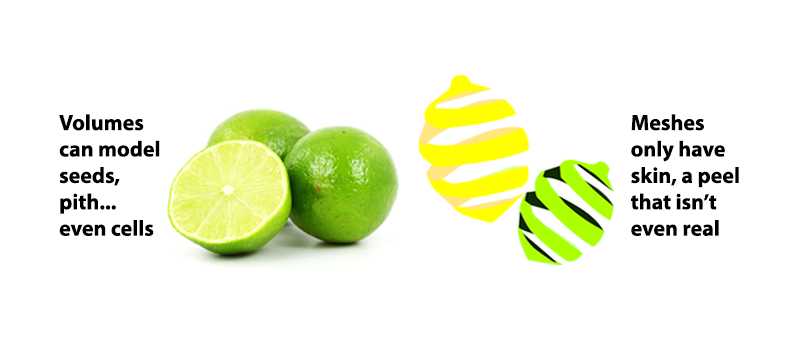
Inside vs. Outside
Whoa whoa whoa. What does 'intangible polygons' mean?
Imagine trying to carve a sculpture into a potato if it only had a skin (and that skin didn't even exist, haha). You can't sculpt something out of nothing! That's a mesh.
The best a mesh can do is simulate internal structure by making yet more mesh polygons inside of your model. But if you look inside those polygon shapes, they are yet again empty.
Up until now, 3D rendering in a computer has been all about superficial appearances, because the surface is all that we typically see when watching 3D animations or video games, or creating models that don't need a true internal structure.
So the intangible polygon skin was enough - until now.
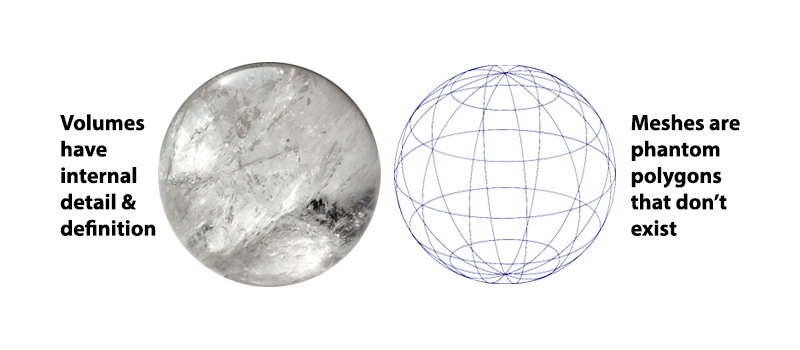
Why It Matters
If mesh can simulate internal structure, why do we need volumes?
Think about a marble. It may look like a simple child's toy, but it also has a beautifully intricate internal structure that is impossible to model with mesh polygon surfaces. Consider all the little imperfections and color variations that make it look “real”.
With meshes, the closest you can get to making a model of this marble is with illusions like graphics and shaders. This works if you only need to look at it from the outside in a game or cartoon.
Your only option to make the unique and delicately varied internal structure of this marble with mesh would be to make hundreds or thousands of yet more empty polygon structures inside of the larger spherical structure, and the insides of those shapes will still have no depth or definition.
Therefore, the difference between a mesh and a volume matters for a couple of big reasons:- Tools - First, when you design a model, the kinds of tools you can use for sculpting depend on the geometry of the object. By converting a mesh to a volume, you are then able to use our spiffy Volume tools like Blend and Subtract, which require the model to have a defined internal structure.
- 3D Printing - The second big reason becomes apparent when you print your object out into the real world, and you want defined internal structures (volume), instead of just hollowness or a solid brick (mesh).
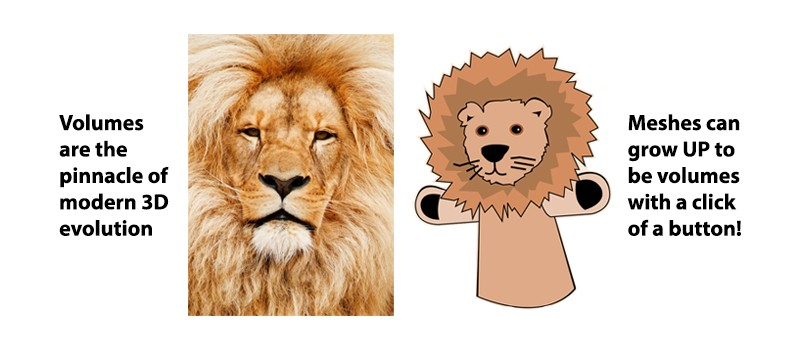
3D Printing Changed Everything
What does this have to do with 3D printing?
With the invention of 3D printing, it's a whole new situation. Now that you are able to materialize an object into the real world, it would be pretty helpful if you could define more than just the surface!
And this is where volumes come in. By converting an object to a volume, you can actually design all the inside parts and beautiful depth of detail that empty meshes simply do not have.
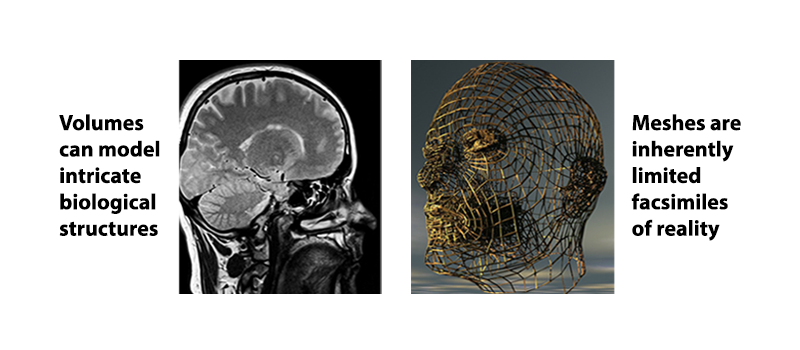
It's the Inside that Counts…
So you're telling me I could model the inside of a piece of fruit - or the human brain?!
Yes!
You can define detailed internal structures - mathematical, biological, artistic. With these powerful volumetric tools, you can now build anything you can imagine from the inside out, and manifest it into the real world.
Volumes provide solid, tangible architecture, making sure what you see on screen is what comes out of your 3D printer, right down to the tiniest details.
With volumes, you can model intricate internal structures, define surface thickness, and ensure a watertight print every time!
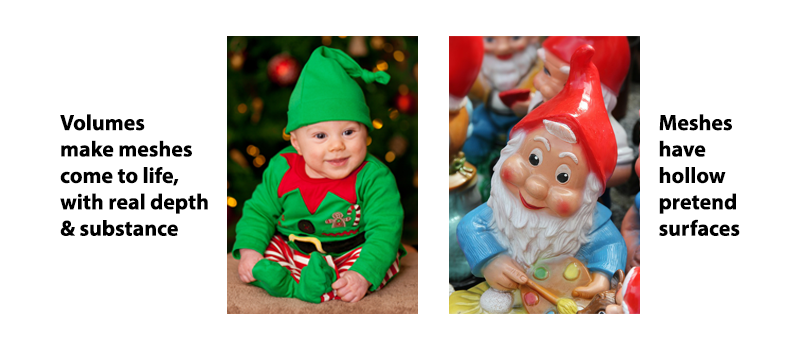
Real Depth vs. Intangible Surface
I think I need to see another picture to be sure I fully understand…
Why certainly!
Every object in MeshUP is a true 3D volume (not voxels or parametric surfaces), because the software reduces each object's whole volume to a pure mathematical function, instead of an approximation of only the surface of that object.
This results in the ability to accurately represent real objects inside and out, opening up a wide range of new, innovative features and solutions for the 3D design space.
It means we can re-imagine computer aided design and manufacturing, where for the first time humans can explicitly create complex objects at the scale and quality of nature.
So if you want to give your 3D models real internal structure, volumes are the way to do it. And we've created a way to make it easy for you.
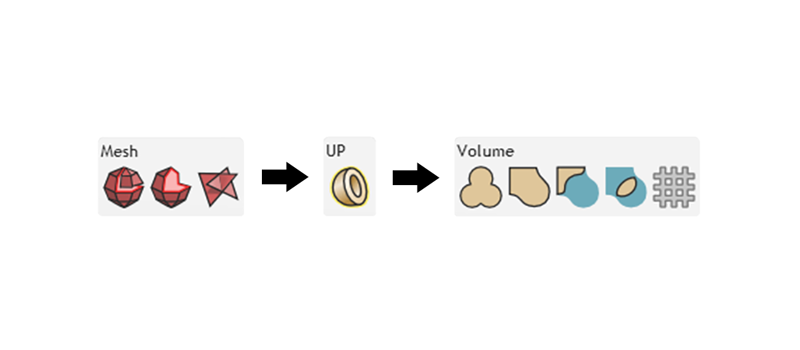
It's Easy to Make Volumes
Wow, volumes are awesome! How do I make one?- Mesh Repair - The first step in making a volume is to repair as many of the defects in the mesh as you can, using the Mesh Repair tools like Seam, Patch, Seal, and Separate Shells.
- UP - Then you will be able to use that fancy UP button to materialize a real 3D volume!
- Envelope - Remember that the UP Envelope option will make a volume even if the model has thousands of defects. So don't worry if you didn't repair every single defect, you can still make a watertight volume with Envelope.

Welcome to the Playground!
So I can still use all the cool meshes I have?
Yes! Meshes still have an important role to play, because we have so much wonderful content that has been built in that format.
MeshUP is made specifically to help you convert your existing meshes into volumes, so that you can enjoy playing with our volumetric tools without having to start over from scratch. Therefore, meshes give us an excellent playground for dreaming up the next generation of 3D models, as the field continues to grow and evolve.
You're a part of technological history, by taking this step forward into giving meshes real depth and substance. While the primary intention is to empower 3D printing applications, you can imagine how useful it is to be able to model actual internal structure for a number of fields. Medicine, research, education, art… anything you can imagine!
We welcome you to come share all the cool ways you discover to use MeshUP in our Community Forums!